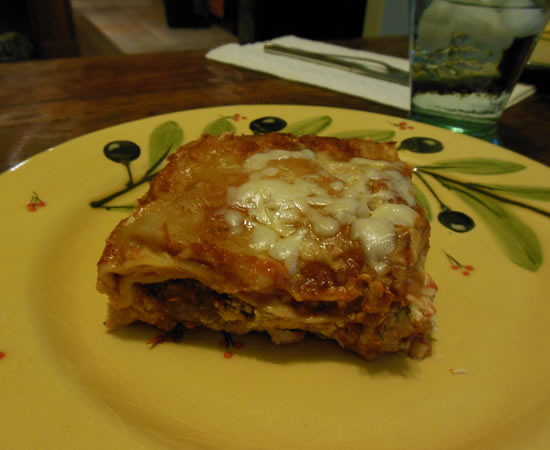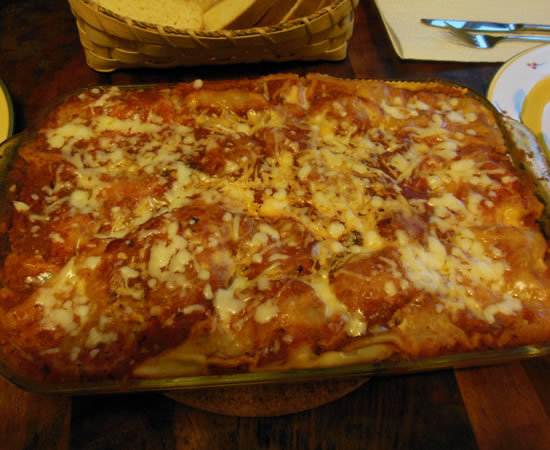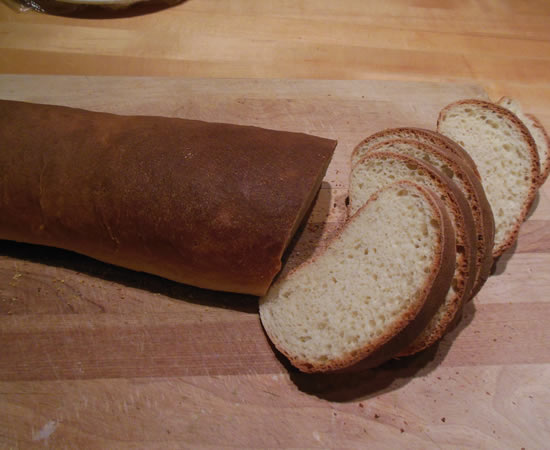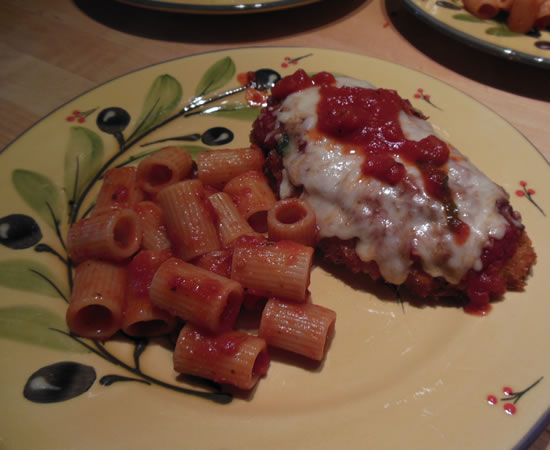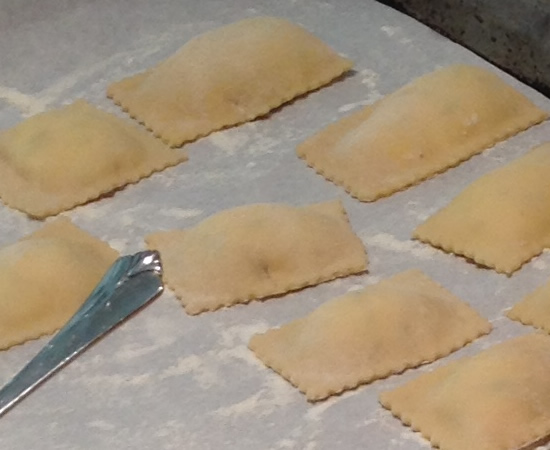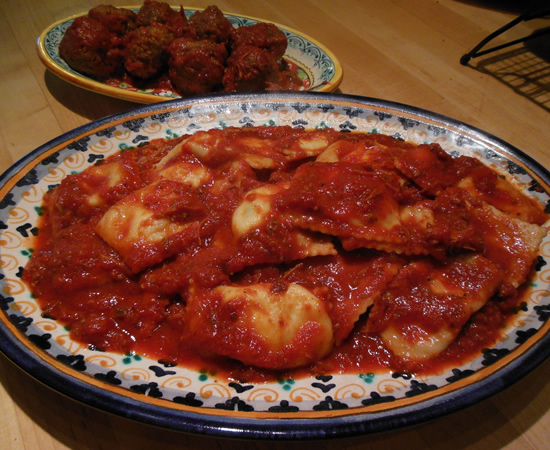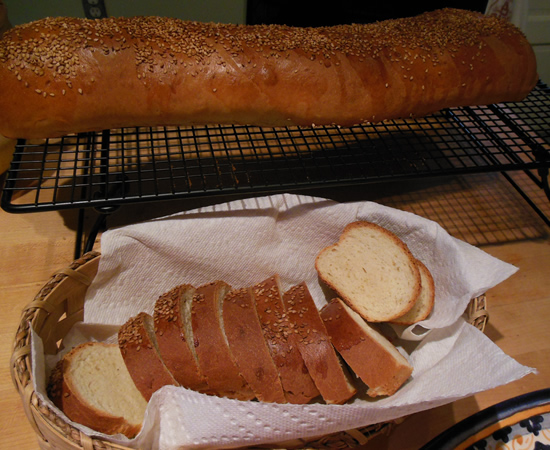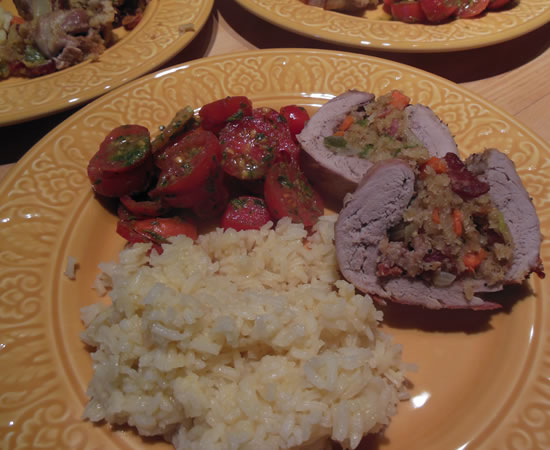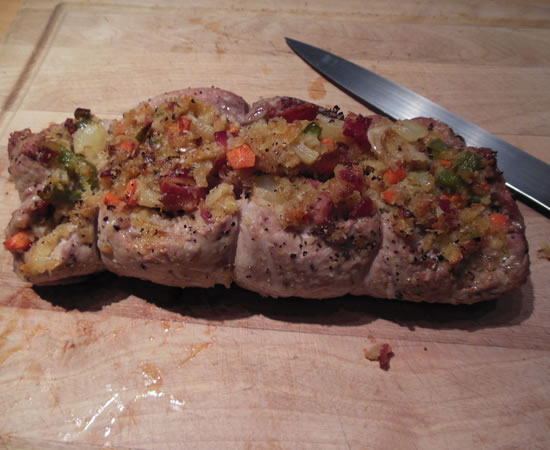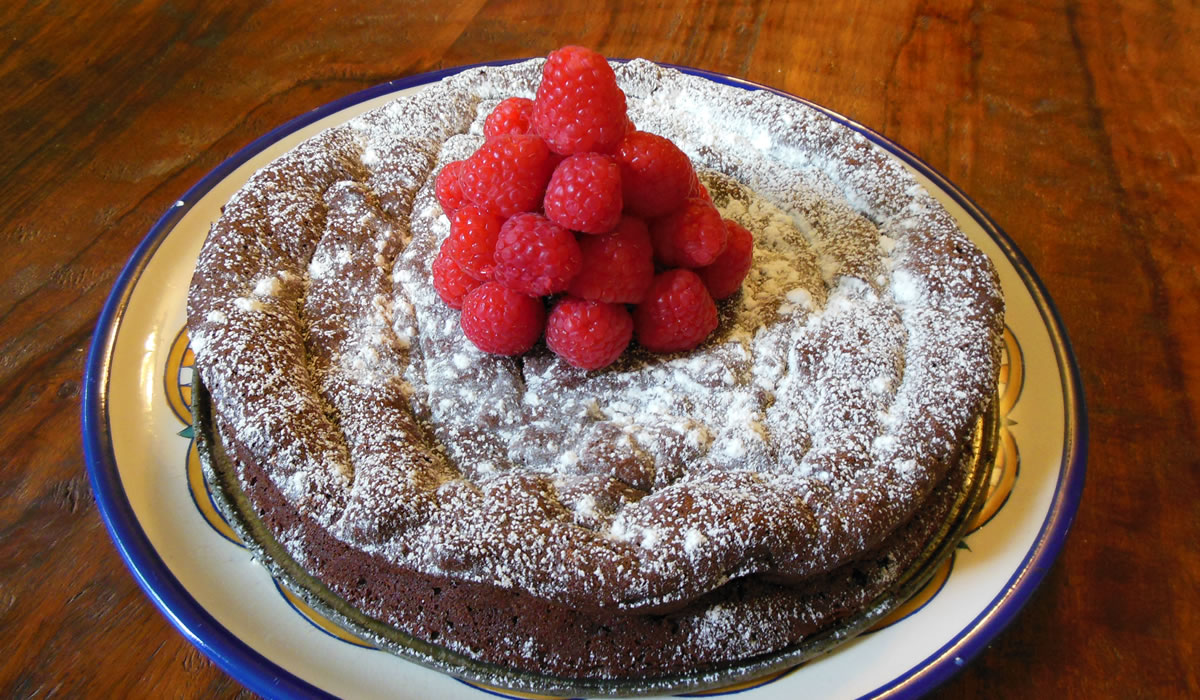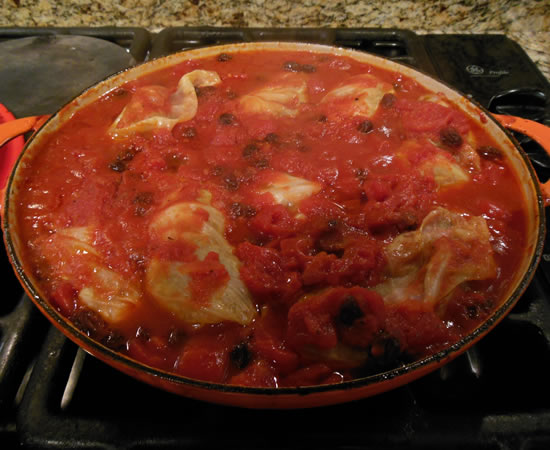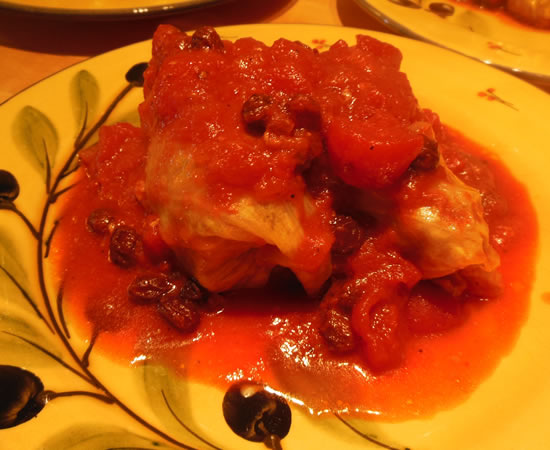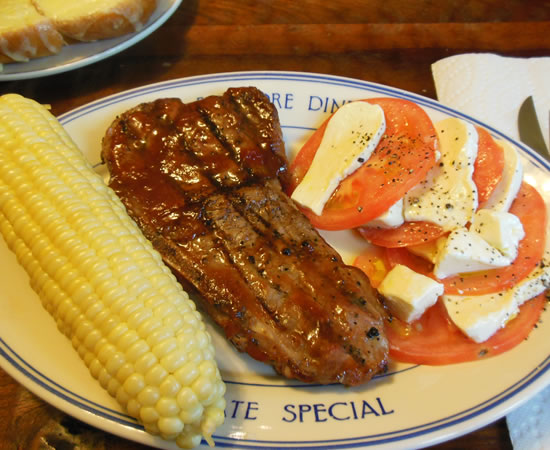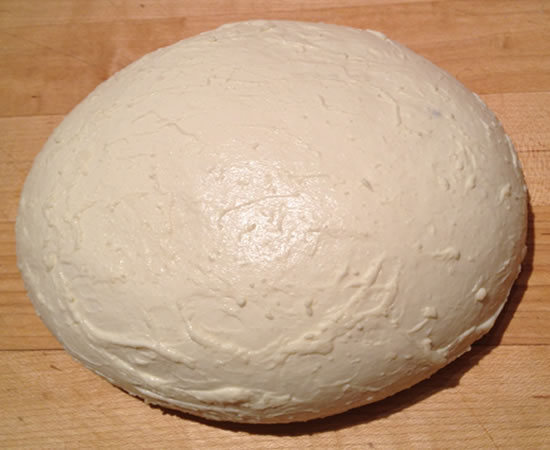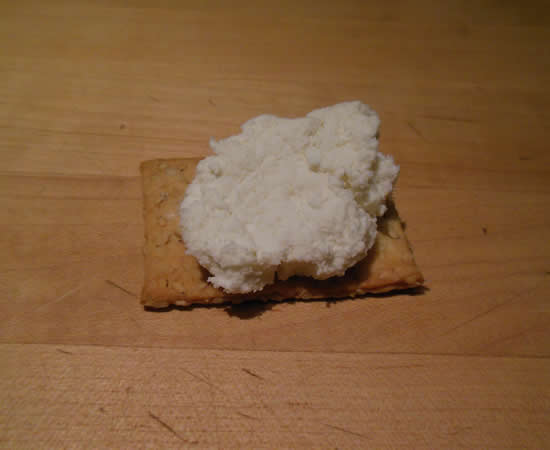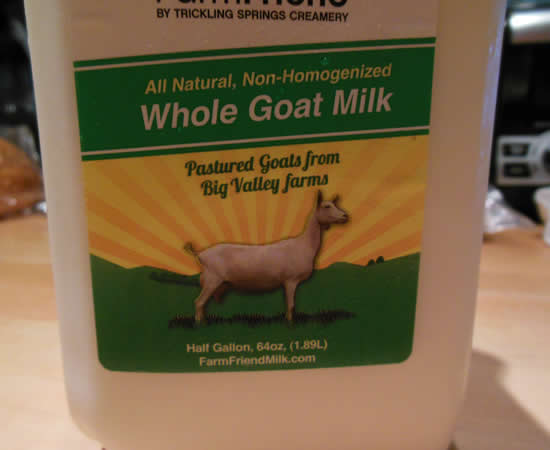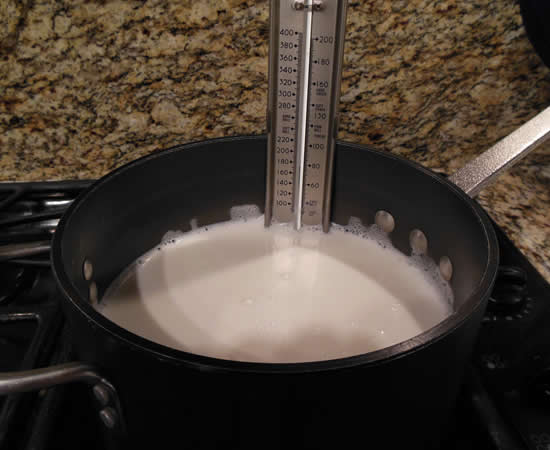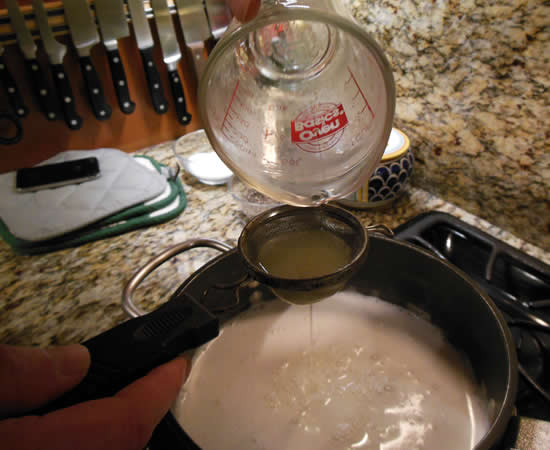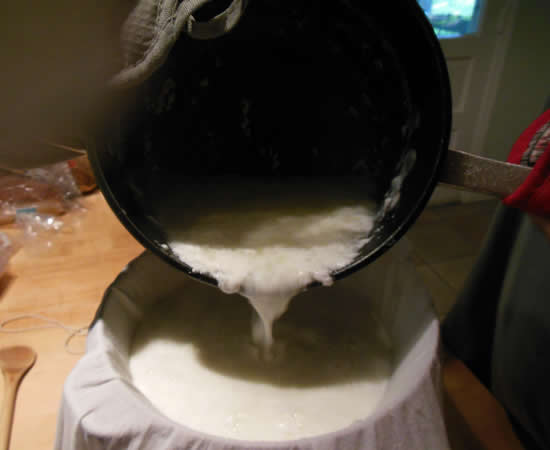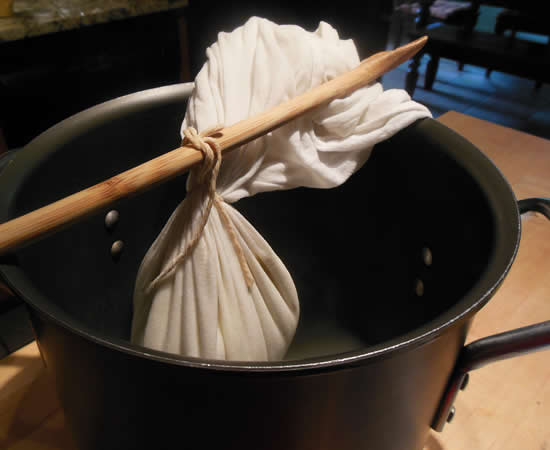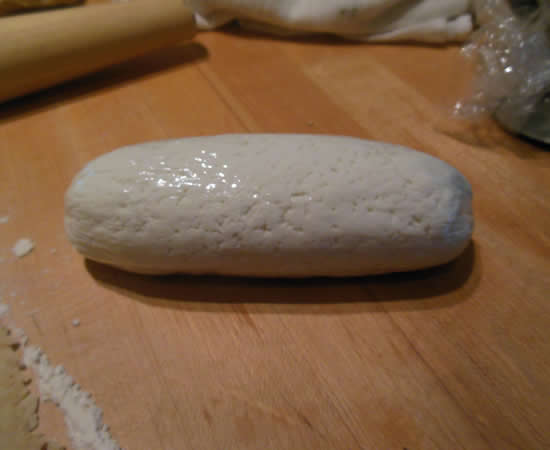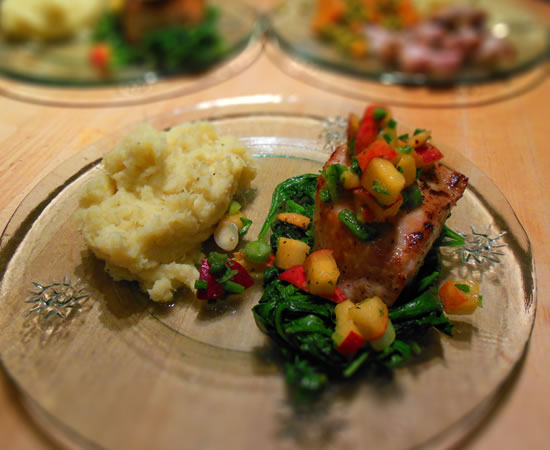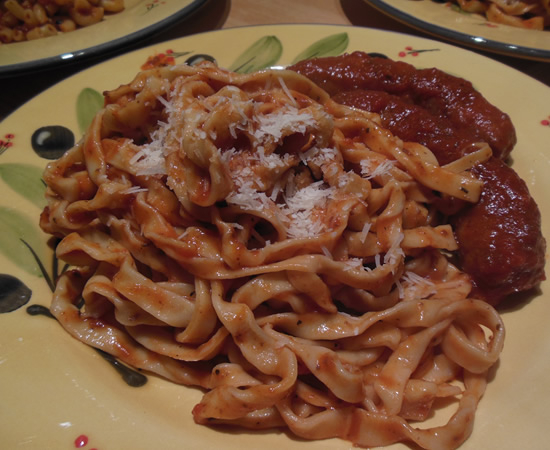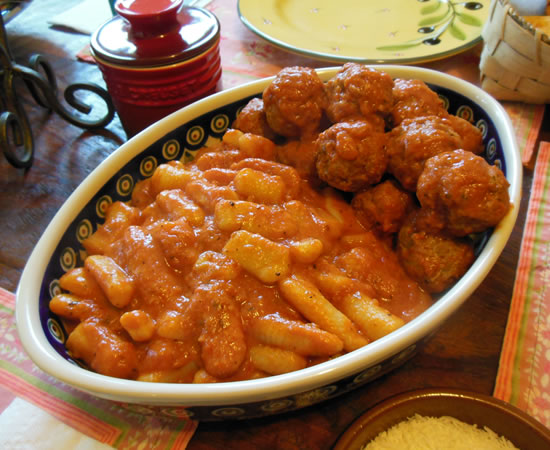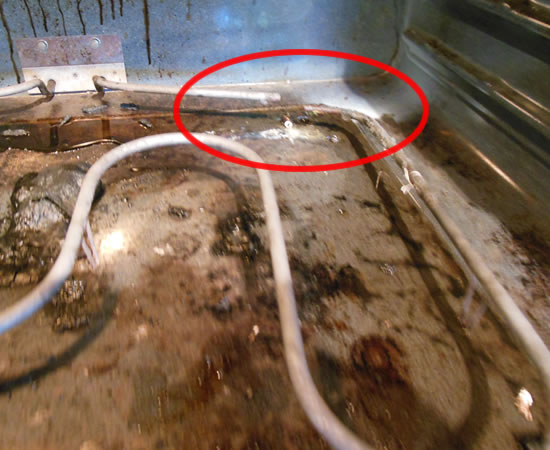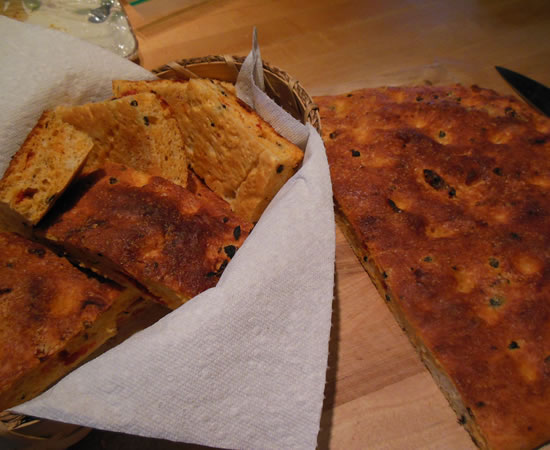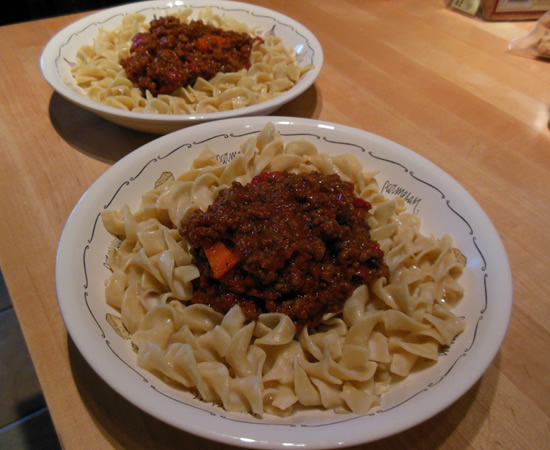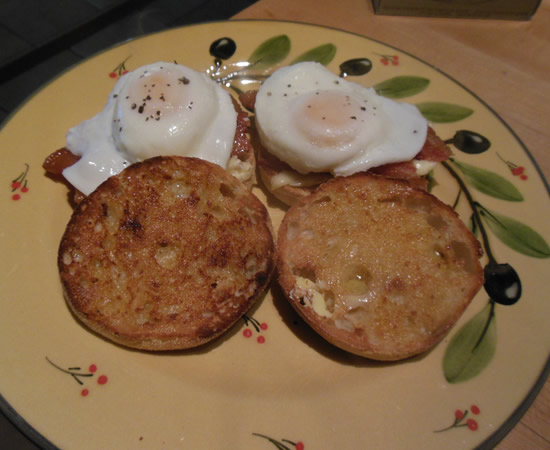Lasagne
Homemade lasagne with light-as-a-feather homemade lasagne noodles. It just doesn't get any better. Really.
This morning Victor asked if I would like lasagne for dinner. I said "yes" so fast I scared myself. No one in their right mind - or me - could possibly turn down an offer like that!
Victor went to work making his basic sauce with Italian sausage and let it simmer while he made the pasta.
The pasta is his go-to recipe he adapted from Lydia and he uses it for many of his fantastic pasta dishes.
Cooking fresh and cooking from scratch isn't as difficult - or impossible - as we are led to believe. Food manufacturers are the ones who are telling us we're "too busy to cook" because they want to sell us their mass-produced-faux-food with the questionable ingredients devoid of any real nutrition. You really can get dinner on the table without opening a lot of boxes and not once turning on the microwave - and you can do it in no time, at all.
What it does take, however, is an actual desire to do it. I am so glad that desire is in our house.
Fresh Egg Pasta
- 3 cups all-purpose flour
- 4 large eggs
- 1 tsp olive oil
- ½ tsp salt
Spoon 2 3/4 cups of the flour into the work bowl of a food processor fitted with the metal blade. Beat the eggs, olive oil and salt together in a small bowl until blended. With the motor running, pour the egg mixture into the processor. Process until it forms a rough and slightly sticky dough. If the mixture is too dry, drizzle in a very small amount of warm water and continue processing. Scrape the dough out of the work bowl onto a lightly floured counter.
Knead the dough with the heels of your hands until it is smooth, silky and elastic – 5 to 10 minutes of constant kneading.
Flour the work surface and your hands lightly any time the dough begins to stick while you’re kneading.
Roll the dough into a smooth ball and place in a small bowl. Cover and let the dough rest at least an hour before rolling and shaping.
This time around he made sheets of pasta and simply trimmed them all to size. And since it was fresh pasta, he didn't cook it first.
The dish was layered with sauce, pasta, cheeses - mozzarella, provolone, asiago, parmesan, romano, and ricotta - pasta, sauce, sausage, more cheese more pasta, more sauce...
It was covered and then went into a 350° oven for an hour.
It came out and cooled and set for about 3 hours and then went back in for 30 minutes covered, and 30 minutes uncovered - again, at 350°. The first bake-and-cool set the lasagne so it cut easily and held its shape after being reheated.
It was awesome! The pasta was light as a feather and the filling a perfect blend of flavors. I put a pretty good piece on Nonna's plate and when she saw it she exclaimed that it was too much. She ate every bite and said she wanted it for dinner again, tomorrow! Too much, indeed. Victor and I actually went back for seconds, although they were definitely smaller portions the second time around.
We also had a loaf of fresh bread to accompany dinner. I couldn't let a homemade lasagne get paired with a store-bought loaf!
This is a James Beard recipe, adapted from his Beard on Bread cook book.
Italian Feather Bread
Makes 2 free-form loaves
- 2 packages active dry yeast
- 1 tbsp granulated sugar
- 1 cup warm water (100° to 110° )
- 1/3 cup butter, cut into small pieces
- ¾ cup hot water
- 2 tsp salt
- 5½ to 6 cups all-purpose flour
- Cornmeal for the pan
Stir the yeast, sugar, and warm water together in a large mixing bowl; let sit till yeast dissolves and starts to proof. In the meantime, melt the butter in the hot water and let cool to lukewarm. Add the salt, and combine with the yeast mixture.
Add the flour, 1 cup at a time, until the dough almost comes away from the sides of the bowl.
Turn out the dough onto a lightly floured board. Using a baker’s scraper or a large spatula, scrape under the flour and dough, fold the dough over, and press it with your free hand. Continue until the dough has absorbed enough flour from the board and becomes easy to handle. Knead for 2 to 4 minutes, being sure to keep your hands well floured, because it is still a sticky dough.
When the dough is soft and smooth, let rest for 5 or 6 minutes and then divide into two. Roll each half into a rectangle about 12” long and 8” wide. Starting from the wide end, roll this up quite tightly, pinching the seams as you roll.
Butter one or two baking sheets well (I used one) and sprinkle with cornmeal. Place the loaves on the sheets, and let them rise in a warm, draft-free place until doubled in bulk.
Bake in a preheated 425° oven 40 minutes, or until the loaves are a rich, golden color and make a hollow sound when you tap the crust, top and bottom, with your knuckles. Cool on a rack and slice when quite fresh.
I wrapped one loaf after it cooled and put it in the freezer. I'd rather make a full recipe and freeze than make a half-recipe.
Everything was so good I didn't even butter my bread - and I always butter my bread.
There's enough lasagne for lunch tomorrow and half will go into the freezer for another meal in the coming weeks.
Yum.
Chicken with Peppers
Underneath that seemingly-innocent cheese and sauce are peppers. Hot peppers from our yard just screaming to be eaten.
I've said a dozen - or more - times how great these peppers have been and every time we use them for something the love affair starts all over again.
Victor started off with a fairly traditional breaded chicken breast - fried to set the crumbs and then baked in the oven about 20 minutes.
he then topped them as one would a basic chicken parmesan - but then things took a twist. Before adding the cheese, he added a slew of fried peppers and then covered them all with cheese. Back into the oven to melt the cheese.
Brilliant.
It took dinner to the next level and beyond.
It's just a matter of taking the ordinary and adding a twist. Tonight peppers. Another time chopped olives from the olive bar. Or pesto. Or sliced hard-cooked eggs.
Imagination.
Homemade Ravioli and Meatballs
I have just had one of the most awesome dinners of my life! I feel like dancing a Tarantella! I am [almost] speechless - and we know how rare that is. My stomach is not only smiling, it is beaming.
And what, you say, could make me feel this way?!? Ravioli. Yes. A simple ravioli. But not just any simple ravioli - a simple ravioli made by hand - by Victor.
Little cheese-filled clouds floating on a sea of impossibly-rich tomato sauce. Meatballs that defy description. Firm, yet fork-tender, with body and substance bursting with flavor.
I have died and gone to gastronomic heaven.
Really.
Did I mention speechless?!?
Victor has pasta dough down to a science. There are certain things that come naturally to some - and pasta-making is as natural to him as breathing. He has the knack and the feel for the dough and just knows when it's right. He has used a variation on a Lidia recipe for years and it's always perfect. But tonight it was more perfect than ever before.
He made a 3-cheese filling that would make an Italian Nonna cry. It was bursting with flavor while simultaneously screaming simplicity. And the sauce... It was the last of our freezer-stash and was gently improved upon. Our live-in Nonna filled her plate and then went back for seconds. Nonna never goes back for seconds.
Fresh Ravioli
Ravioli Dough
- 2 cups all-purpose flour
- 2 eggs
- 3 tbs water
- 1 tsp olive oil
- Pinch of salt
Break eggs into a small bowl and mix with water, olive oil and salt. In a bowl add flour and wet ingredients. Mix together with a fork until all the flour we wet and it begins to come together. Knead on a lightly floured surface about 3 minutes until the dough is smooth and elastic. (if too dry add a bit more water by the DROP – until the dough forms) – cover in plastic wrap and let rest for an hour.
Filling:
- 1 - 15oz container of whole milk ricotta (we don’t use no stinking “part skim”)
- 1 – cup shredded whole milk mozzarella (see first ingredient regarding part skim)
- 1 – cup grated parmesan cheese – and please for God’s sake use a good one – no Kraft or anything that comes out of a green can!!!
- 2 - Eggs lightly beaten
- Finely chopped garlic – to taste. I used two good size cloves – You can use garlic powder but you may lose your “Italian Card”.
- Chopped Parsley – to taste – I like a lot and I use parsley grown in my garden. However you will not be penalized for buying it fresh at the store. But you will be shot on site if you use McCormack’s dried parsley.
Mix all ingredients together. Taste for seasoning and add S&P, as desired.
To assemble:
Make an egg wash of 1 egg and 2 tbsp water. Mix well.
Using a pasta roller, roll pasta to setting 6. If using a rolling pin, roll pasta about 1/16th of an inch. Thin.
Cut into squares. Brush all 4 edges of square with egg wash. Place a dollop of filling in the middle of each and top with another square of pasta. Crimp edges to seal and place on a floured sheet pan covered with a kitchen towel.
Repeat.
To cook:
Place ravioli in gently-boiling water and cook about 5 minutes - more or less according to the thickness of your dough.
Serve with your best sauce. They're worth a good sauce.
Awesome doesn't begin to describe.
And since we were having a more-than-awesome fresh ravioli, I made bread to go along with it.
An Italian Bread based on a James Beard recipe.
Italian Bread
- 2 pkgs active dry yeast
- 1 tbsp sugar
- 1 cup warm water [100° to 115° F, approximately]
- 1/3 cup butter
- 3/4 cup hot water
- 2 tsp salt
- 5 1/2 to 6 cups all-purpose flour
- cornmeal
- Sesame seeds
Stir the yeast, sugar and warm water together in the bowl of a stand mixer; let sit until yeast dissolves and starts to proof.
In the meantime, add the butter to the hot water and let cool to lukewarm.
Add 5 cups of flour and the salt to the yeats mixture and mix with a dough hook on low until the dough almost comes away from the sides of the bowl, adding up to 1 more cup of flour, if needed to make a soft dough.
When the dough is soft and smooth, let rest for 5 or 6 minutes and then divide into two. Roll each half into a rectangle about 12″ x 8″. Starting from the wide end, roll the rectangle up quite tightly, pinching the seams as you roll. Grease a large sheet pan or use parchment paper and sprinkle liberally with corn meal. Place loaves on pan and cover with a kitchen towel. Let rise until doubled in bulk, about 50 to 60 minutes.
Preheat to 425° F while the bread proofs.
When proofed, brush loaves with an egg wash and sprinkle liberally with sesame seeds.
Place in oven and bake about 40 minutes or until well-browned and hollow-sounding when tapped.
The whole dinner was seriously awesome.
And I think we're all going to be fighting over the leftovers for lunch, tomorrow...
Stuffed Pork Tenderloin
I just love it when Victor cooks. Especially when it's an unexpected meal.
I was working on a project when out of the blue Victor asked if I minded if he cooked dinner. "Oh, yes, honey. I mind completely" NOT!!! Cook away!
What was even more fun was he had no idea what he wanted to make. We had a pork tenderloin thawed, but that was the extent of the planning.
He decided on a stuffed tenderloin.
- Bacon
- Carrots
- Green bell pepper
- A small bulb of fennel
- Onion
He cooked the bacon till it was very crisp - took it out, chopped the veggies and sauteed them in the bacon fat. While that was happening he found some stale rolls and made bread crumbs in the food processor - dumped the veggies in a bowl, crumbled the bacon into them - added the bread crumbs - a bit of olive oil and milk... Slit open the pork loin - pounded it out a bit, stuffed the sucker, rolled it up (called me in to tie it for him - a guy needs "some" help) and roasted it for 45 mins at 350°.
Fresh tomatoes out of the garden. Sliced and slathered in home made pesto.
Rice cooked in chicken stock for flavor.
Nonna and I both cleaned our plates. Completely cleaned our plates.
It was one of those perfect meals. Every flavor worked with every texture, worked with everything.
The pesto with the tomatoes was another perfect combo. The basil has really taken off and we're going to be making a lot more of it in the next week.
And the tabasco peppers are getting close, too...
Happy Birthday To Me!
Another birthday. How sweet it is!
61. A nice number. Other than a few aches and pains, I'm feeling pretty good. And today, I've been eating good!
Victor decided to cook for me - something that is always appreciated. What was even more appreciated is he made a dish he'd never make for himself - even though he does like it. Stuffed Cabbage.
But first - birthday cake.
This is a knock-off of a Flourless Chocolate Cake from Tyler Florence. Victor's been making it for years, now and I really - really - like it.
Nonna took one look at the cake and said "Is that the cake? What happened to it?" We laughed and told he that's what it was supposed to look like. She was unconvinced.
Victor’s Flourless Chocolate Raspberry Cake
Ingredients
- 1 pound bittersweet chocolate, chopped into small pieces
- 1 stick butter
- 9 large eggs, separated
- 3/4 cup granulated sugar
- 1 pt raspberries, mashed with a fork
- 1/4 cup strong espresso coffee
Directions
Preheat the oven to 350°. Butter a 9-inch springform pan.
Melt chocolate and butter together.
Beat egg yolks and sugar in a mixing bowl until light yellow in color. Stir in a little of the chocolate mixture into the egg yolk mixture to temper the eggs then mix in the rest of the chocolate mixture. Stir in coffee and raspberries and mix well.
Beat the egg whites until stiff peaks form. Fold into the chocolate mixture.
Pour into the prepared pan and bake until the cake is set, the top starts to crack and a toothpick inserted into the cake comes out with moist crumbs clinging to it, 35 to 40 minutes. Let stand 10 minutes, then remove sides of pan.
Mound some raspberries on top and voila! Dessert is served!
It's rich, it's fudgy, it's mouthwateringly delicious.
And then we have the stuffed cabbage. We did eat this before cake. Really.
This is an Ina Garten recipe. We can usually count on the Barefoot Contessa to have a decent recipe.We both like her style. Victor made this a couple of years ago for the first time and really enjoyed it. Cabbage is not anywhere on his top 100 list of foods, so I was actually surprised the first time he made it. And pleased. I love cabbage and just never cook it.
Stuffed Cabbage
Ingredients
- 3 tablespoons good olive oil
- 1 1/2 cups chopped yellow onions (2 onions)
- 2 (28-ounce) cans crushed tomatoes and their juice
- 1/4 cup red wine vinegar
- 1/2 cup light brown sugar, lightly packed
- 1/2 cup raisins
- 1 1/2 teaspoons kosher salt
- 3/4 teaspoon freshly ground black pepper
- 1 large head Savoy or green cabbage, including outer leaves
For the filling:
- 2 1/2 pounds ground chuck
- 3 extra-large eggs, lightly beaten
- 1/2 cup finely chopped yellow onions
- 1/2 cup plain dried breadcrumbs
- 1/2 cup uncooked white rice
- 1 teaspoon minced fresh thyme leaves
- 1 1/2 teaspoons kosher salt
- 1/2 teaspoon freshly ground black pepper
Directions
For the sauce, heat the olive oil in a large saucepan, add the onions, and cook over medium-low heat for 8 minutes, until the onions are translucent. Add the tomatoes, vinegar, brown sugar, raisins, salt, and pepper. Bring to a boil, then lower the heat and simmer uncovered for 30 minutes, stirring occasionally. Set aside.
Meanwhile, bring a large pot of water to a boil.
Remove the entire core of the cabbage with a paring knife. Immerse the head of cabbage in the boiling water for a few minutes, peeling off each leaf with tongs as soon as it s flexible. Set the leaves aside. Depending on the size of each leaf, you will need at least 14 leaves.
For the filling, in a large bowl, combine the ground chuck, eggs, onion, breadcrumbs, rice, thyme, salt, and pepper. Add 1 cup of the sauce to the meat mixture and mix lightly with a fork.
Preheat the oven to 350°.
To assemble, place 1 cup of the sauce in the bottom of a large Dutch oven. Remove the hard triangular rib from the base of each cabbage leaf with a small paring knife. Place 1/3 to 1/2 cup of filling in an oval shape near the rib edge of each leaf and roll up toward the outer edge, tucking the sides in as you roll. Place half the cabbage rolls, seam sides down, over the sauce. Add more sauce and more cabbage rolls alternately until you ve placed all the cabbage rolls in the pot. Pour the remaining sauce over the cabbage rolls. Cover the dish tightly with the lid and bake for 1 hour or until the meat is cooked and the rice is tender. Serve hot.
Everything about it was good. Nonna almost licked her plate. After wiping mine with bread, it was clean enough to go back in the cupboard.
I liked it. A lot.
It was a successful meal and a successful day!
I'm thinkin' 61 is gonna be a good year.....
Steaks and Fresh Mozzarella
Victor made homemade mozzarella on Saturday. O.M.G. It's too wonderful to even begin to describe!
And while it takes a bit of finesse, it's not as difficult as it seems. Which is good, because I already want more!
He's been doing really good with his cheese-making - goat cheese and ricotta in the past couple of weeks - but this one was the trickiest, to date. And he nailed it!
The two biggest no-nos are that you can't use ultra-pasteurized milk and you can't use Junket rennet. You're making cheese - go for the quality. We bought organic whole milk and used organic goat milk for the chevre. You're taking the time to do it - so do it right.
You need a good thermometer and rubber gloves. Clean rubber gloves - not the ones you use for scrubbing floors and stuff.
There are a lot of recipes for making mozzarella on the web, and most of them are pretty similar. This is an adaption of a few of them.
Okay... start!
Fresh Mozzarella
- 1 1/4 cups water, divided
- 1 1/2 tsp citric acid
- 1/4 rennet tablet or 1/4 tsp liquid rennet (NOT Junket rennet)
- 1 gallon whole milk, NOT ultra-pasteurized
- 1 tsp kosher salt
Prepare the Citric Acid and Rennet:
Measure out 1 cup of water and stir in the citric acid until dissolved. In a separate cup, measure out 1/4 cup of water and stir in the rennet until dissolved.
Warm the Milk:
Pour the milk into the pot. Stir in the citric acid solution. Set the pot over medium-high heat and warm to 90°, stirring gently.
Add the Rennet:
Remove the pot from heat and gently stir in the rennet solution. Count to 30. Stop stirring, cover the pot, and let it sit undisturbed for 5 minutes.
Cut the Curds:
After five minutes, the milk should have set, and it should look and feel like soft silken tofu. If it is still liquidy, re-cover the pot and let it sit for another five minutes. Once the milk has set, cut it into uniform curds: make several parallel cuts vertically through the curds and then several parallel cuts horizontally, creating a grid-like pattern. Make sure your knife reaches all the way to the bottom of the pan.
Cook the Curds:
Place the pot back on the stove over medium heat and warm the curds to 105°F. Stir slowly as the curds warm, but try not to break them up too much. The curds will eventually clump together and separate more completely from the yellow whey.
Remove the Curds from Heat and Stir:
Remove the pan from the heat and continue stirring gently for another 5 minutes.
Separate the Curds from the Whey:
Ladle the curds into a strainer set over a bowl to catch the whey.
Heat the curds:
Warm a large pot of water to just below boiling (about 190°). Set the strainer into the pot so the curds are submerged in the hot water. Let the curds sit for about five minutes. Wearing rubber gloves, fold the curds under the water and check their internal temperature. If it has not reached 135°F, let the curds sit for another few minutes until it does. The curds need to reach this temperature in order to stretch properly.
Stretch and Shape the Mozzarella:
Sprinkle the salt over the cheese and squish it with your fingers to incorporate. Using both hands, stretch and fold the curds repeatedly. It will start to tighten, become firm, and take on a glossy sheen. When this happens, you are ready to shape the mozzarella. You can make one large or several smaller balls. Just don't over-work it.
Store the finished cheese:
Place the mozzarella balls in slightly salted water or whey. Keep refrigerated and use within a week.
This is such a treat. When we get back from vacation and the tomatoes are in full production, I think we'll be seeing a lot more of this!
Yumlicious!
The steaks were covered in the Peach BBQ Sauce I made yesterday. Fresh corn on the cob...
We're doing well...
Homemade Chevre
Who woulda thunk that some goat milk and some lemon juice could create something so outrageously good?
I'm impressed. Really impressed.
Victor started with the cheese-making a while back with homemade ricotta. We've had it a few times - mostly as a dessert. It's really awesome, rich, and fun to use. Today, he decided it was time to try chevre.
There are several ways to make a homemade chevre, with lemon juice, vinegar, buttermilk, and any number of commercial starters with a score of unpronounceable ingredients. Today, we opted for the basic lemon juice.
The concept is pretty simple.
Start with a half-gallon of goat milk. NOT ultra-pasteurized - which you shouldn't buy, anyway.
Slowly heat milk until it reaches 180°
Add lemon juice and stir. Let sit for 10 minutes.
Pour into a cheesecloth-lined colander. Victor used a flour sack towel.
Hang the bundle over the pot to drain with a wooden spoon.
Shape it into a log and chill.
Homemade Chevre
adapted from About.com
- 1/2 gal quart goat's milk
- 2/3 cup fresh lemon juice
- salt to taste
Slowly heat the milk on the stove until it reaches 180°. Gentle bubbles should be forming and the surface will look foamy. Turn off the heat.
Stir in the lemon juice then let the milk sit for 10 minutes. The milk should curdle and become slightly thicker on the surface.
Line a colander with two layers of cheese cloth. Gently pour the milk into the cheese cloth then gather the cheesecloth up around the curds and tie it into a bundle.
Hang the bundle over a pot so the liquid can drip out. (You can do this by attaching the bundle to a wooden spoon or a ladle and setting the spoon over the top of the pot.)
Let the cheese drain for at least 1 1/2 hours. Scrape the cheese into a bowl. Stir in salt and/or other ingredients to taste.
Use your hands to pat and shape the cheese into a small wheel or log.
The flavor and texture of the cheese usually improves a little bit if you refrigerate it for a few hours before serving. The goat cheese should stay fresh in the refrigerator for 1 week.
This really, really is awesome! It's not difficult and can be made with items many folks already have at home.
And if you have kids? A great project to get them to see how real food is made and a way to get them to eat something different.
We'll be making more. And more. And more.
Pork Chops and Peach Salsa
Everything but the pork chop is courtesy of my shopping trip to Gentile's on Monday. We started off with white sweet potatoes - mashed with butter and sour cream. Basic and good.
Fresh spinach cooked in a drizzle of olive oil, salt, pepper, and a pinch of garlic. How could it be bad? And then a simple peach salsa with fresh peaches, jalapeños, green onions, and cilantro. Oops. I lied. The cilantro came from the garden.
The pork chop was pan-seared then finished off in the oven. Perfectly tender. All of the various flavors worked well...
And now for another flavor - fresh figs.
I have an idea for a roasted fig over ice cream.
I'll be back!
Hand-Made Pasta
O.M.G. What a great pasta!
Tonight was a double-treat. Victor decided to cook and he decided to make a slightly different pasta than he usually makes. Years ago he bought me a pasta roller for my birthday or Christmas, and I've never used it. It wasn't out of the box 20 minutes when he made some pasta - and he's been making it ever since.
And trust me, I'm not arguing. His pasta is fan-freakin-tastic every time. I see no reason to try my hand at it when his is just so perfect. He makes it. I eat it.
Works for me.
This particular pasta is a bit more versatile than some - it could be rolled thick or thin and used as a fettuccine as we had tonight, or as a rolled dumpling for Chicken and Dumplings. His original fear was that it might be too eggy or like a typical egg noodle. It wasn't and isn't. I'm sure I'll be able to convince him to make it, again!
Fresh Egg Pasta
- 3 cups all-purpose flour
- 4 large eggs
- 1 tsp olive oil
- ½ tsp salt
Spoon 2 3/4 cups of the flour into the work bowl of a food processor fitted with the metal blade. Beat the eggs, olive oil and salt together in a small bowl until blended. With the motor running, pour the egg mixture into the processor. Process until it forms a rough and slightly sticky dough. If the mixture is too dry, drizzle in a very small amount of warm water and continue processing. Scrape the dough out of the work bowl onto a lightly floured counter.
Knead the dough with the heels of your hands until it is smooth, silky and elastic - 5 to 10 minutes of constant kneading.
Flour the work surface and your hands lightly any time the dough begins to stick while you’re kneading.
Roll the dough into a smooth ball and place in a small bowl. Cover and let the dough rest at least an hour before rolling and shaping.
The sauce was from the hoard in the freezer that he doctored up a bit.
My stomach is smiling!
Malloreddus, Focaccia, and a Broken Oven
I worked a rare Sunday shift, yesterday, and came home to fresh, homemade pasta and a focaccia just ready to go into the oven. How sweet it is.
Victor and I were standing in the kitchen talking right after the focaccia went into the oven when we both noticed a bright light in the oven. Little fires, flames, and flare-ups are not totally unusual in our ovens because we use them all the time and don't always clean them as often as we should.
But this wasn't a little flare-up. It was a bright white arc of heat on the element.It was immediately apparent that something was amiss, so I turned on the bottom oven to heat while we turned off the top. We have an arcing oven, but we also have a sheet of fresh focaccia that we are not letting go to waste. We have our priorities!
The nice thing about ovens is they are reasonably solid and insulated. A small flame inside of one is not going to burn down the house. The secret is to keep the flame inside. In this case there was no flame - just an arc of intense heat moving long the electric element like a lit fuse. Very bizarre.
I opened the oven door slowly - the ol' introduction of oxygen to a fire precaution - and moved the focaccia to the bottom oven, all the while fascinated by the glowing element. It had broken clean through and right past the break the arc was moving along the element just like a fuse. While it had a way to go before reaching the end of the element - and the electrical wires in back of the oven - it didn't really look like it would go out on its own. It needed a bit of help.
No, I do not have a fire extinguisher in the kitchen. Guilty as charged. But I do have a level head in emergencies, so I did what any son of a fireman would do. I used a sopping wet rag and tongs. It took a few minutes of gingerly playing with it - while Victor was across the room with the phone and 9-1 dialed - but I was able to cool it and put it out in just a couple of minutes. The focaccia came out of the bottom oven and we let everything cool completely. And then we made sure the circuits were off downstairs.
We then sat down to a fabulous dinner - homemade Malleddorus, homemade focaccia, and homemade meatballs and sauce. Victor added Boursin cheese to the sauce I had made and frozen. It came out great
Malloreddus are like a gnocci - just slightly-different ingredients, but they're similarly formed. Victor first got the recipe from la Cucina Italiana. It really is good.
Malloreddus
- Sea Salt
- 1 ¼ cups semolina flour
- ¾ cup unbleached all purpose flour
- Extra virgin olive oil
Gnocchi board or a table fork
Dissolve 1 tsp salt in ¾ cup warm water. In a large bowl whisk together semolina and all purpose flour; mound and form a well in the center.
Add water mixture and 2 tsp olive oil to the well. Using your hand or a fork, slowly incorporate flour from inside the rim of the well. Continue until liquid is absorbed, then knead in bowl until dough forms a complete mass (dough will be slightly sticky).
Transfer dough to a well floured work surface and knead, dusting with a bit more flour as needed just to keep dough from sticking to your hands, for 5 minutes. Wrap dough tightly in plastic wrap and let rest for 30 minutes.
Break off about 1/8 of the dough; tightly rewrap remaining dough. Roll dough into ½ inch cylinder, and cut into ¼ inch thick pieces. Pressing with your thumb, roll each piece on a gnocchi board (or down the back of a fork) to give it the characteristic ridges, and put on a floured baking sheet. Repeat with the remaining dough.
To cook fresh Malloreddus, bring a large pot of salted water to a bill. Add pasta and cook until tender, about 6 minutes after water returns to a boil. Drain, transfer to a large serving bowl and immediately toss with sauce and serve.
And then there was the focaccia that started all of this.
Focaccia
- 2 1/2 cups flour
- 1 pkg yeast dissolved in
- 1 cup warm water
- 1 tsp salt
- 1 tbsp sugar
- 2 tbsp olive oil
- 1/2 cup black olives, chopped
- 1/2 cup sun-dried tomatoes in oil, chopped
Knead all ingredients until smooth - about 10 minutes. Cover and let rise until doubled.
Punch down dough and spread out on lightly-greased baking sheet. Let rise again, about 30 minutes. Dimple top of dough with knuckles and place into a 425° oven oven about 20 minutes or until nicely-browned.
So after dinner, we were surveying the damage and decided we could go out and buy a new element, or we could go out and buy a new stainless steel oven. The new oven seems to be winning out. We need a new dishwasher, soon - the current one is rusting, the cook-top is a mess, and the handle to the over-the-stove microwave is super-glued in place.
The upside of using our kitchen every day is we eat some pretty awesome food. The downside is a lot of home appliances are not made to be used like commercial appliances. On the other hand, we have gotten 12 years of use out of the current stuff.
Last year, Victor got new granite counter tops for his birthday. It looks like this year, he's getting all new stainless steel appliances. His birthday is Friday. Perfect timing. We're going shopping.
Double-Sauced Pasta
I hate working late, but I love when dinner is awaiting me when I get home after working late.
Like last night.
With the weather more January than March, a pasta dish was just what Mother Nature ordered. And what a pasta dish it was! Noodles tossed in a béchamel sauce and then topped with a beefy ragù. Pure gastronomic heaven.
It was one of those dishes where each part was perfect on its own but when they were mixed together... fantastico
He started out with a simple marinara we had in the freezer and added ground beef, carrots, and celery and cooked it down until it was very thick.
He then made a thin béchamel sauce - 5 tbsp butter, 5 tbsp flour, 1 qt milk, and a pinch of nutmeg - and then added some freshly-grated parmesan cheese for the Italian influence. When the egg noodles were cooked, he tossed them with the béchamel and plated them in a ring. The ragù went into the center.
It was one of those dishes that everything worked. Perfectly.
The other nice thing was that it made enough for dinner and lunch. The new normal around here is making sure there are plenty of easy lunch options available every day.
Success on every level.
Poached Eggs
Sunday Breakfast... What can be said that hasn't been said before? Probably not much - but that's not going to stop me from adding more...
This morning's gastronomic delight comes courtesy of Victor. He's taking off tomorrow for Dallas for the week and wanted to make sure I had at least one decent meal while he's gone. I tend to eat hot dogs and chili when he's not here. I soaked the beans last night and will be starting a batch in a while.
I had brought home some English muffins yesterday with a vague idea of having them with breakfast, but while I was working on a web design this morning, Victor headed to the kitchen.
He decided he wanted poached eggs and then upped the ante to muffin sandwiches with poached eggs. With bacon. And brie.
Oh lord.
He also wanted the poached eggs to be reasonably the size of the muffins since they were going to be sandwiches. We don't have poaching rings but we do have canning lids. The boy's a genius - the ring was the perfect size. He just set them into the simmering water, cracked the egg inside, and then removed the ring when the egg was set. Did I say genius?!? Genius!
They came out perfect. Finger-licking runny yolks, perfectly-cooked bacon, runny brie, and crunchy-buttery muffin.
With freshly-brewed dark-roast coffee.
It just doesn't get any better.
So I'm off to make the chili. It's 49er Football Food today - and my staple for the week.

